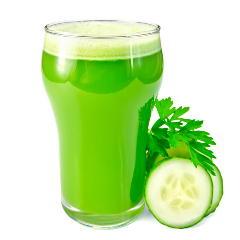 Whether or not you made resolutions for the new year, it's always a good idea to eat more organic produce! Fresh juice is a highly efficient way to consume large amounts of produce and feel incredible. While “juice fasts” have their pros and cons, there is no arguing that adding a freshly made glass of organic juice to your daily routine is beneficial for everyone.
Whether or not you made resolutions for the new year, it's always a good idea to eat more organic produce! Fresh juice is a highly efficient way to consume large amounts of produce and feel incredible. While “juice fasts” have their pros and cons, there is no arguing that adding a freshly made glass of organic juice to your daily routine is beneficial for everyone.
So, what makes juicing so healthy? Juicers break down the cell walls in fruits and veggies releasing their nutrients, which can then be directly absorbed into the bloodstream. Since you don't have to wait for digestion, this gives you an instant energy boost. “Green juices,” made up of green produce such as celery, cucumbers, and leafy greens, supply chlorophyll which helps digestion, neutralizes toxins, and supports liver health. Plus, fresh juice helps promote a healthy alkaline pH in the body and an alkaline body may be less likely to suffer from chronic disease. Most importantly, veggies are full of micronutrients that our bodies need for healthy cell function and antioxidants that clean up toxic by-products and prevent cell damage.
Never is it more important to use organics than when juicing. Since the whole fruit and vegetable is being used, any pesticides or chemicals lurking on the skin will go into the juice and be transported straight to your blood stream. Especially watch out for the “dirty dozen,” a list of the 12 most contaminated foods: apples, celery, leafy greens, peaches, strawberries, blueberries, nectarines, sweet bell peppers, cherries, potatoes, grapes, and lettuce.
Want to try juicing but aren’t ready to invest in a juicer? With a little extra effort you can make juice with your blender. Pre-chop your veggies before adding them, peel any citrus, and remove seeds or stones from fruit. Add about a cup of water and blend. Next, place a tea towel or cheese cloth over a deep bowl and pour your mixture. Once the majority of the liquid has drained twist the towel to squeeze out the remaining juice.
It may be tempting to mix in a wide variety of fruits and veggies when you first start juicing, but it's best to keep it to about three types per juice. Add some herbs such as cilantro or parsley for variety or a bit of peeled ginger for a kick. Stick to one kind of fruit for sweetness since too many quickly add up to higher calories and sugar content.
Juicing is a great way to get a quick boost of nutrients, but if you don’t have the time or equipment to try it at home, smoothies are a great alternative. Not only do smoothies provide the same micronutrients as green juices, but the added fiber can help you stay full longer and slows the absorption of sugar into the blood stream. You can easily add other healthy supplements into smoothies such as protein powders, maca powder, flax and chia seeds. Don’t forget to add the greens! I like spinach because it blends really well, but chard and kale are good options too. Cucumbers add a light, refreshing twist to a smoothie and puree well. Even unconventional vegetables such as beets, broccoli and lettuce are great additions. Happy Juicing!
|
Basic Green Juice
2 green apple
1 inch knob ginger
6 large stalks celery
1 cucumber
1 bunch of parsley
1 bunch of kale
1/2 lemon (with peel, if organic)
|

|

